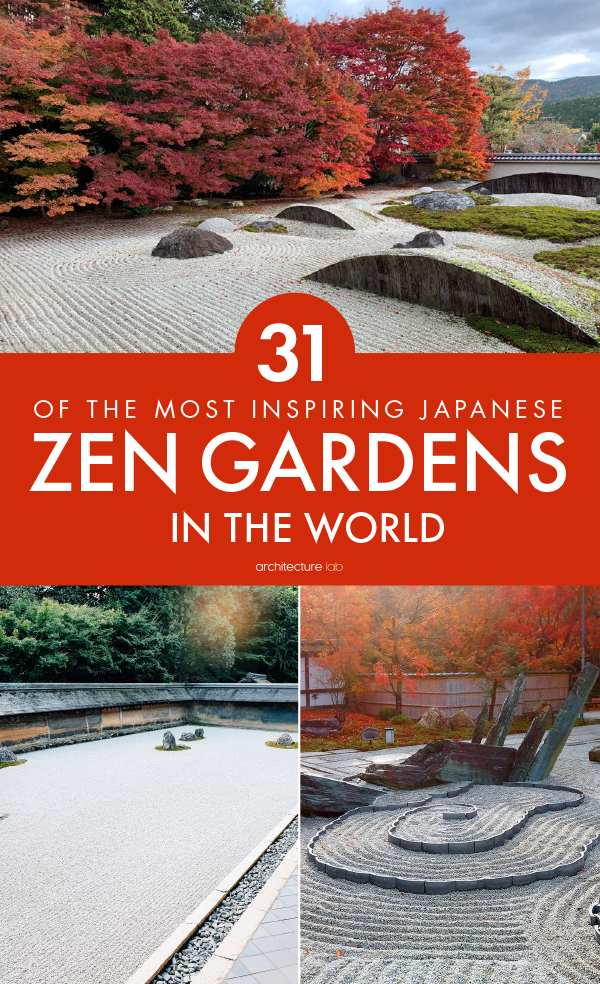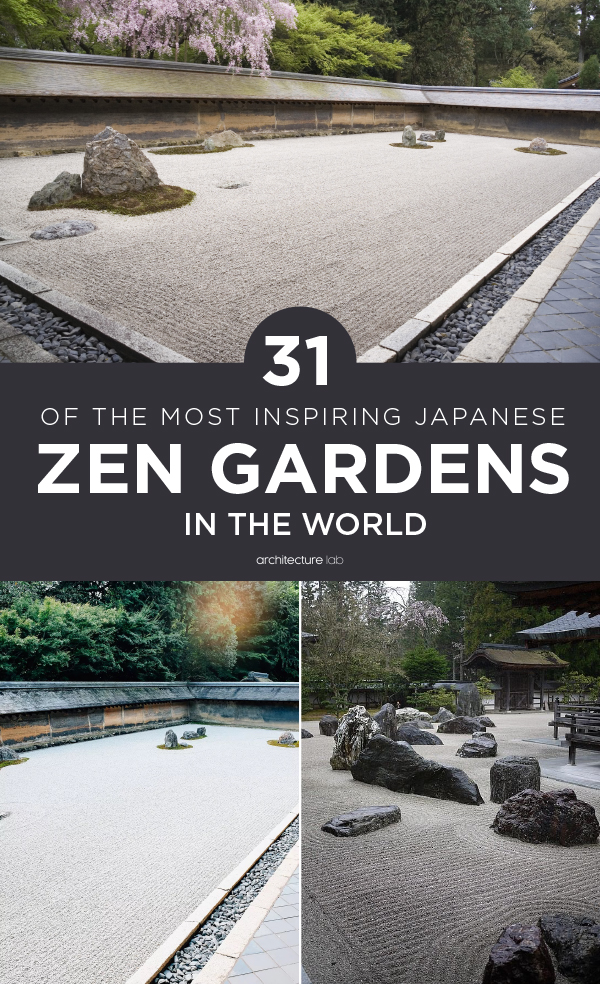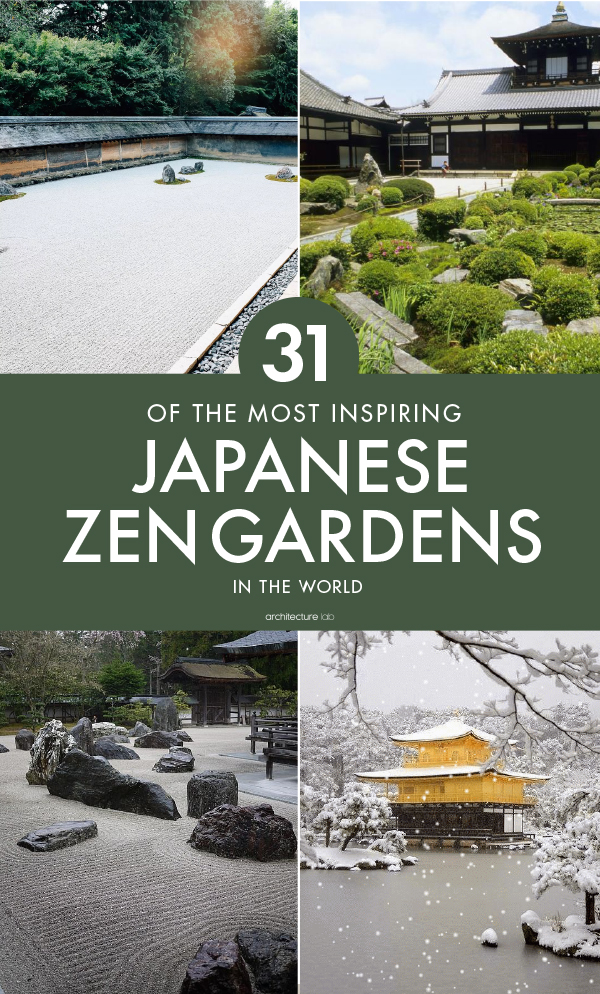A calm sense of serenity, along with an abject desire for meditation, inner discovery, and spirituality, is what best defines Zen gardens. Inspired by the minimalist gardens of age-old Buddhist and Chinese traditions, Zen gardens have slowly but surely permeated into all forms of Japanese cultural space. Minimalism is the key design factor here. A careful arrangement of nothing but boulders and white gravel to create a sort of hypnotic trance is what a Zen garden is all about. Often termed as ‘dry gardens’ or ‘karesansui’ in the original Japanese, Zen gardens exclusively lack all forms of vegetation, to symbolize the state of a calm mind which is devoid of all unnecessary thoughts. Zen gardens today can be found all over the world. As a much sought-after place for meditation and escaping the stress of daily life, Zen gardens are being designed in numerous ways to bring about greater spiritual effects. In our article today, we will be going over 31 of the most inspiring Zen gardens across the world, which are indeed a must-visit pilgrimage spot for both tourists and locals alike.
1. Ryoan-ji Zen Garden (Kyoto, Japan)
Dubbed as the Temple of the Dragon at Peace, Ryōan-ji is one of the finest Zen gardens. It is situated inside the Ryōan-ji Zen Temple in Kyoto, Japan. The temple and its gardens are listed as a UNESCO World Heritage Site. 248 squares of highly polished white gravel along with fifteen stones of different sizes constitute the garden. These are carefully arranged in five groups – one of five stones, two of three each, and the last two with 2 stones each.
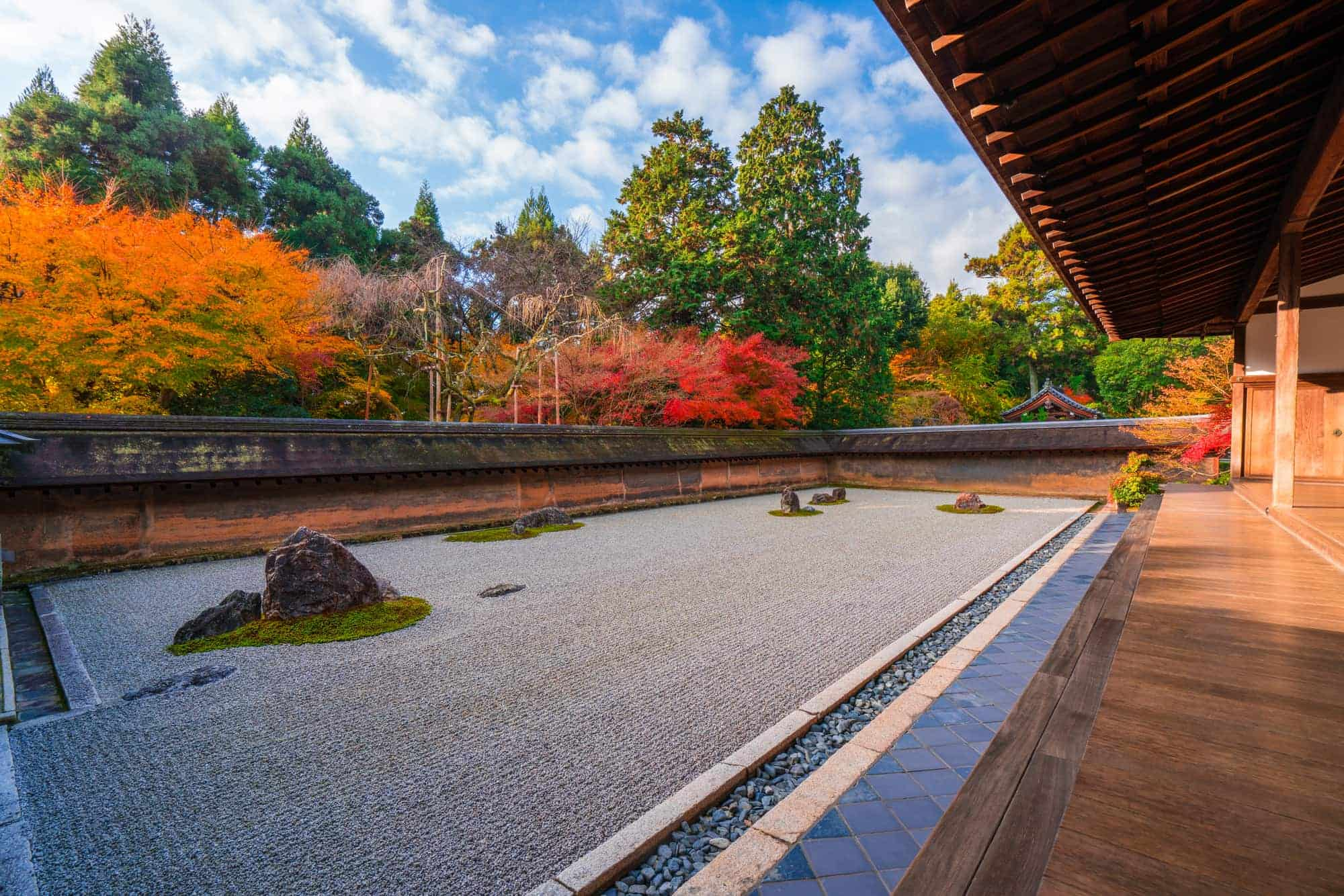
The stones are placed so that the entire composition cannot be seen at once from the veranda. At best, only fourteen boulders are visible from any angle. It is proclaimed that one may only attain enlightenment if one can see all fifteen boulders at once.
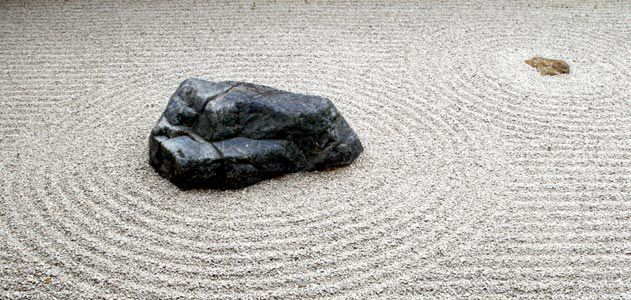
There are several theories put forward related to the symbolism of the garden. Some argue that it represents islands in a stream, while others believe it represents swimming baby tigers or peaks of mountains. Realistically, it’s a composition that encourages meditation, peace, and a way to connect to nature.
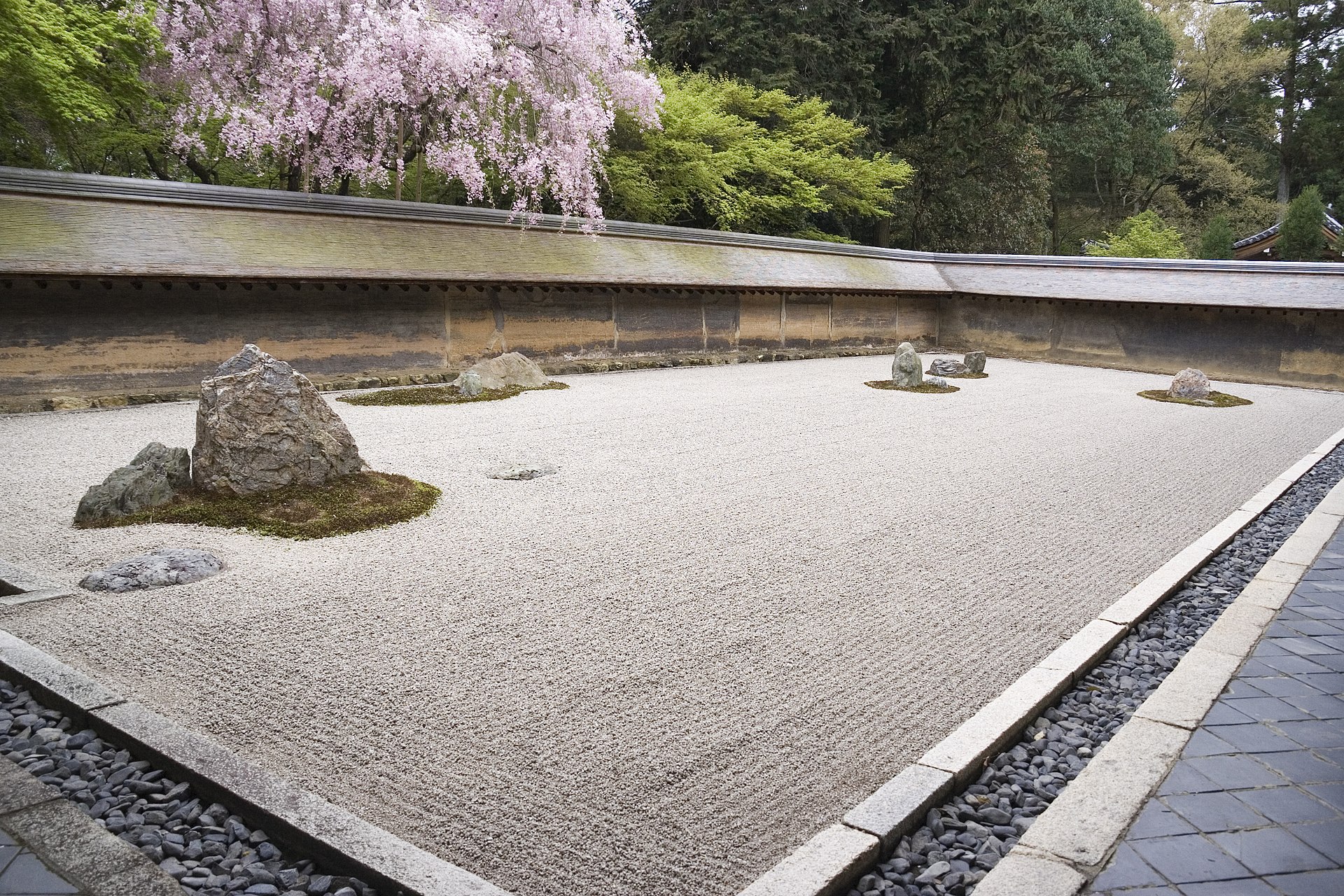
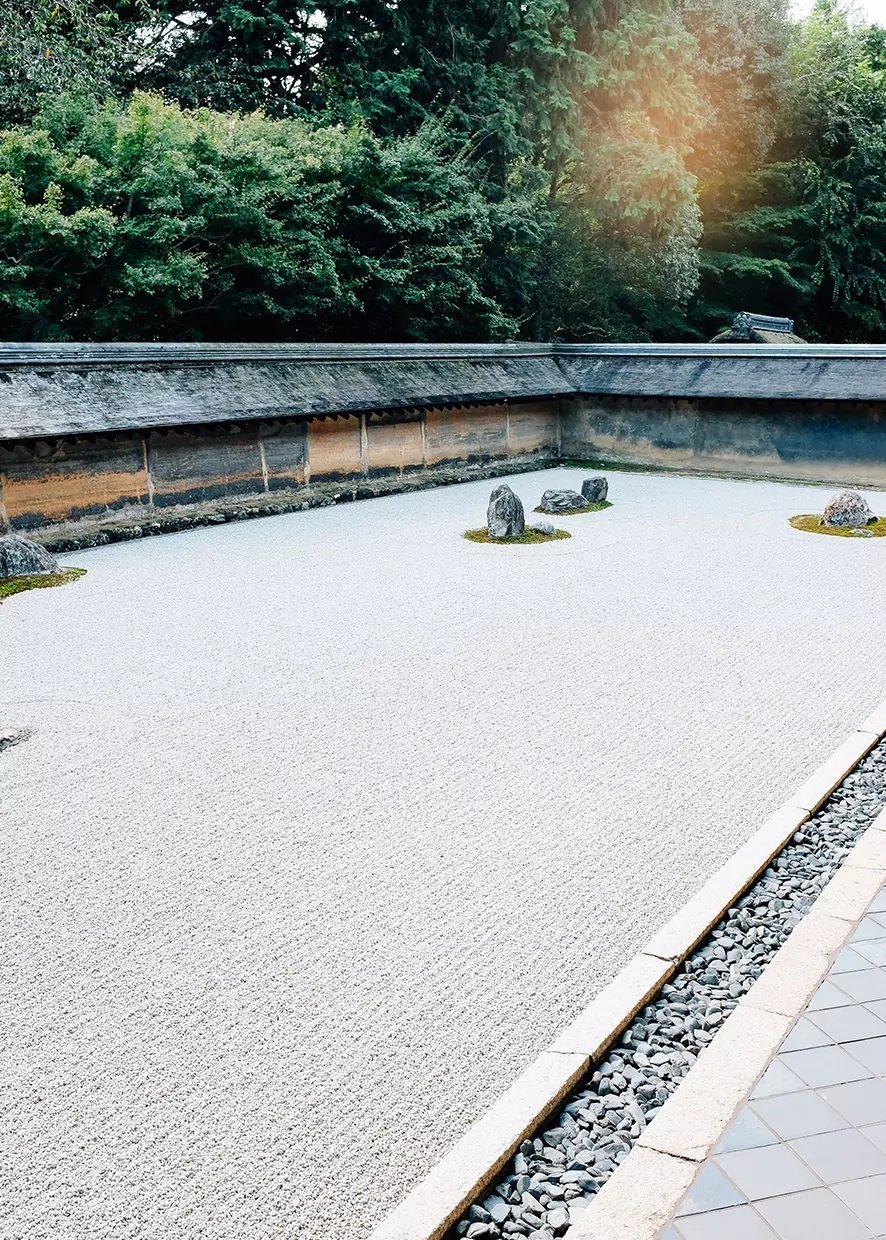
2. Fort Worth Japanese Garden (Fort Worth, Texas)
Fort Worth Japanese Garden exemplifies Japanese tradition in America. Built in 1973 with a contribution from Fort Worth’s sister city Nagaoka in Japan, the garden features two dry landscape gardens. It is a classic fifteen-stone, flat garden composition.

Large boulders represent the Rocky Mountains and smaller pebbles line the valleys in between. Flowing like a waterfall, and perhaps modeled after Daisen-in’s famous Zen garden, the arrangement of elements produces a smaller version of the Colorado River’s run into the Grand Canyon.
Told through stillness and careful arrangement, the Fort Worth Botanic Garden’s Zen gardens are an excellent example of a Japanese tradition in America.
3. Jisso-in (Kyoto, Japan)
Jisso-in Temple is an important, historic temple in the quiet suburb of Iwakura. It is situated in the foothills of Mt. Hiei, in the northeastern region of Kyoto.
The temple has two gardens, a Chisen-Kaiyu garden, and a Karesansui garden. The zen garden is in the front of the temple and has the Hiei Mountain as its shakkei.
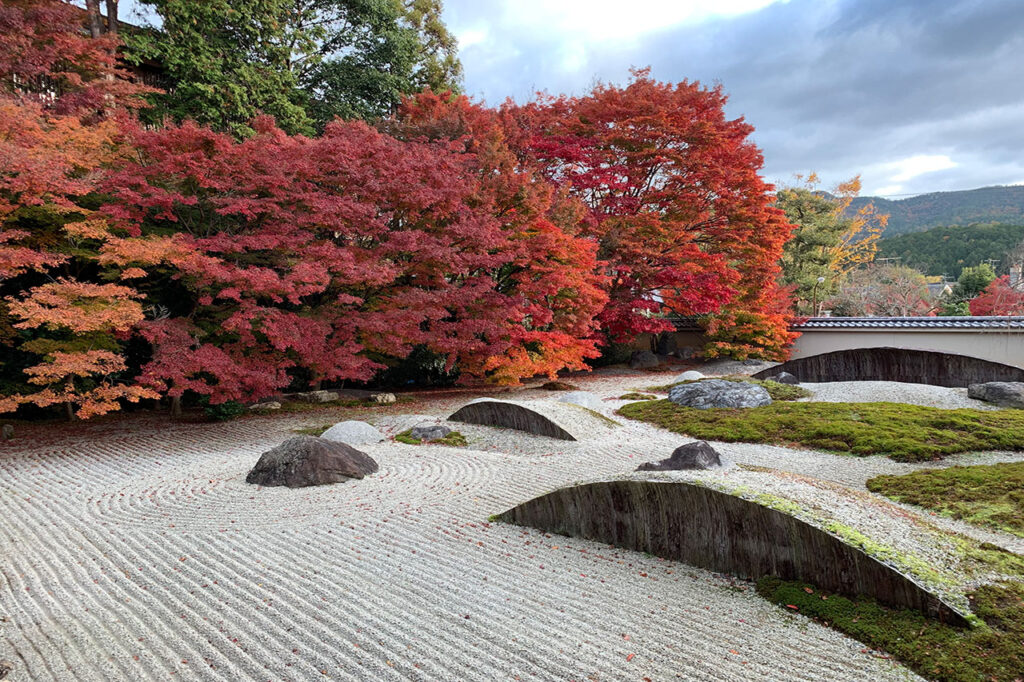
The garden features modern The garden is named “The Heart Garden” and is a representation of modern art. It was reformed in 2014 under the counsel of the renowned garden designer Katsuaki Ogawa.
4. Anyo-in Taisan-ji (Kobe, Japan)
Completed in the late 1500s during the Azuchi–Momoyama period, the Anyo-in karesansui garden is a remarkable sight.
The garden is regarded as one of Japan’s Places of Scenic Beauty, an honor received by few. It features a collection of large rocks and boulders along with the customary white gravel and small pebbles.
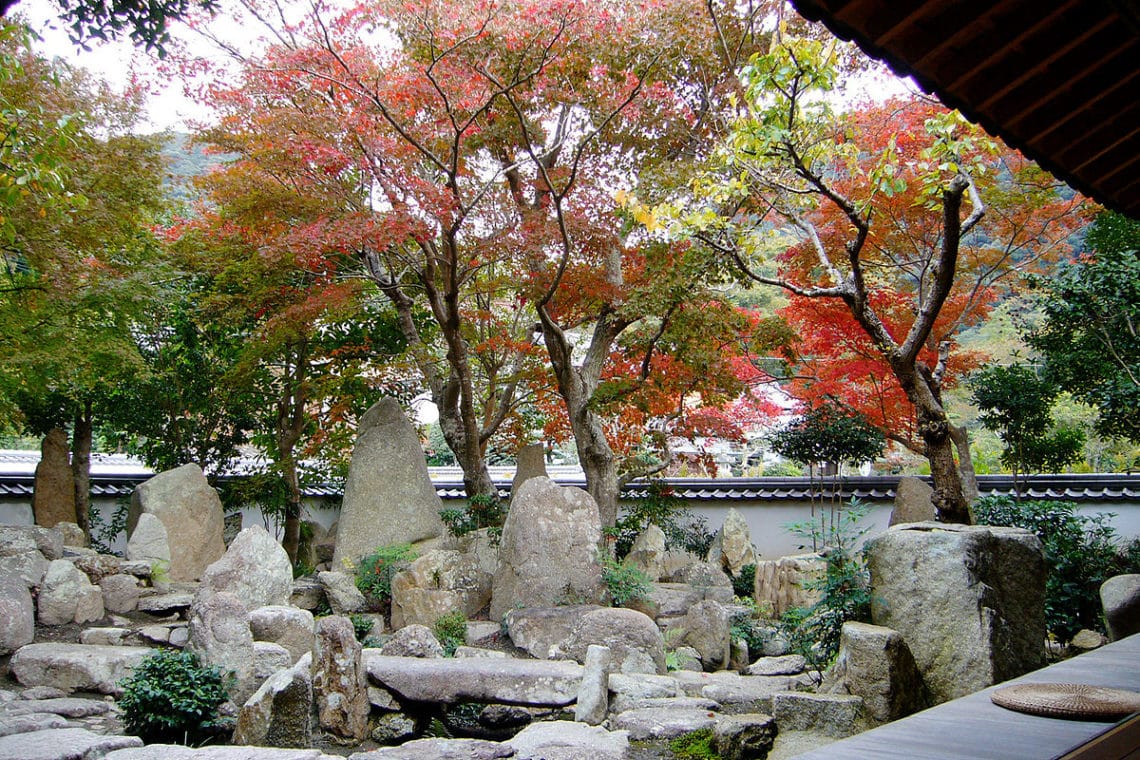
It is not only a beautiful landscape but also serves as a place for meditation and introspection. The garden is best enjoyed from a nearby spot, transcending a serene vibe.
5. Kennin-ji
Famously known as the “The Garden Of The Sound Of The Tide” ” the Chouontei is a simple and refined Zen garden on the premises of the Kenninji Temple. Contrary to most Zen gardens, this garden flourishes with a cover of moss.
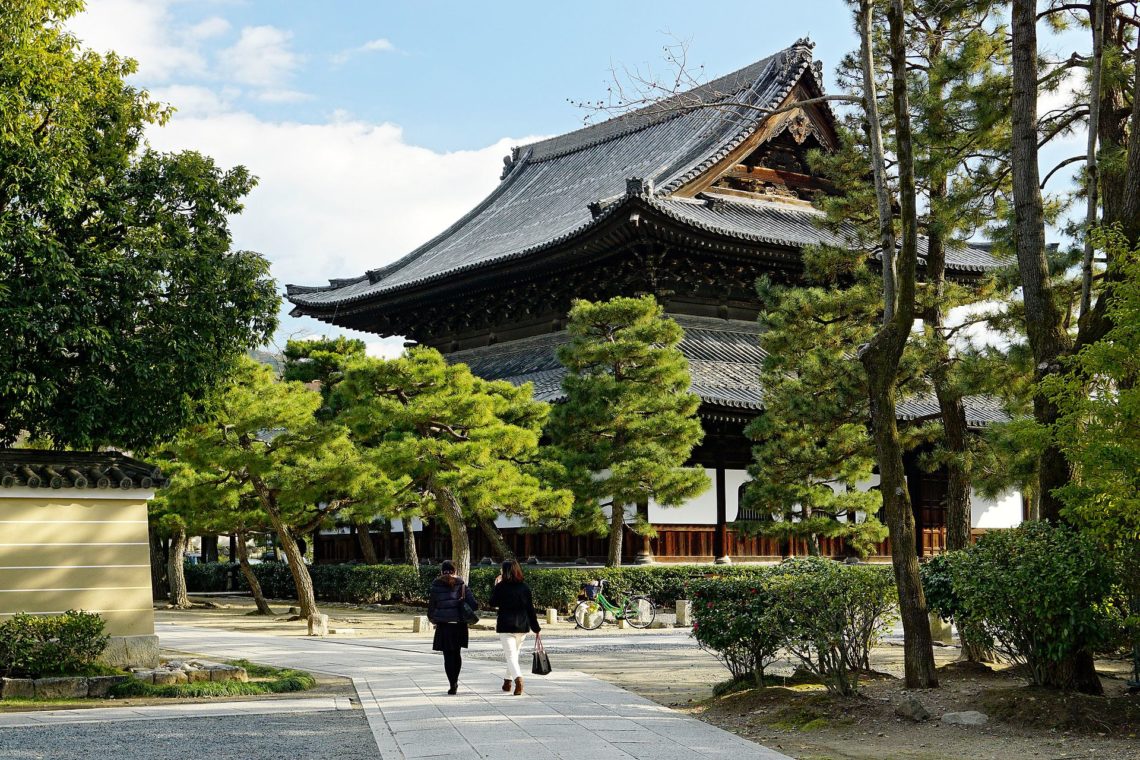
Surrounded by Maple trees on either side, the garden is a composition of three large stones that represent Buddha and 2 Zen monks. The entire area is covered in moss and there is no sign of a gravel bed below the moss. The whole composition affords the visitor an alluring view from all directions.
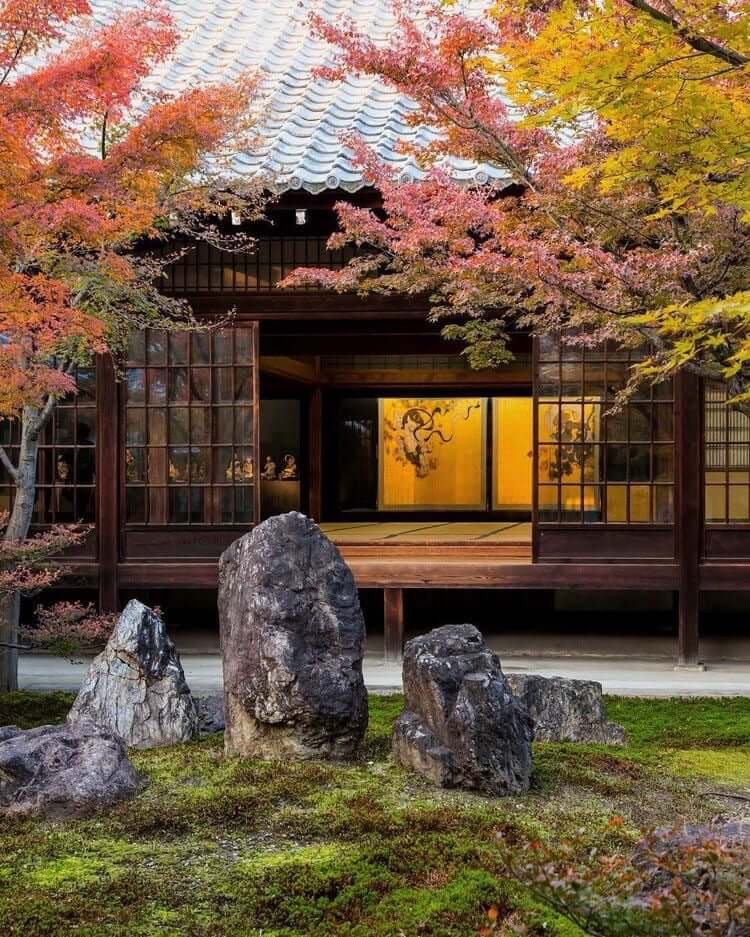
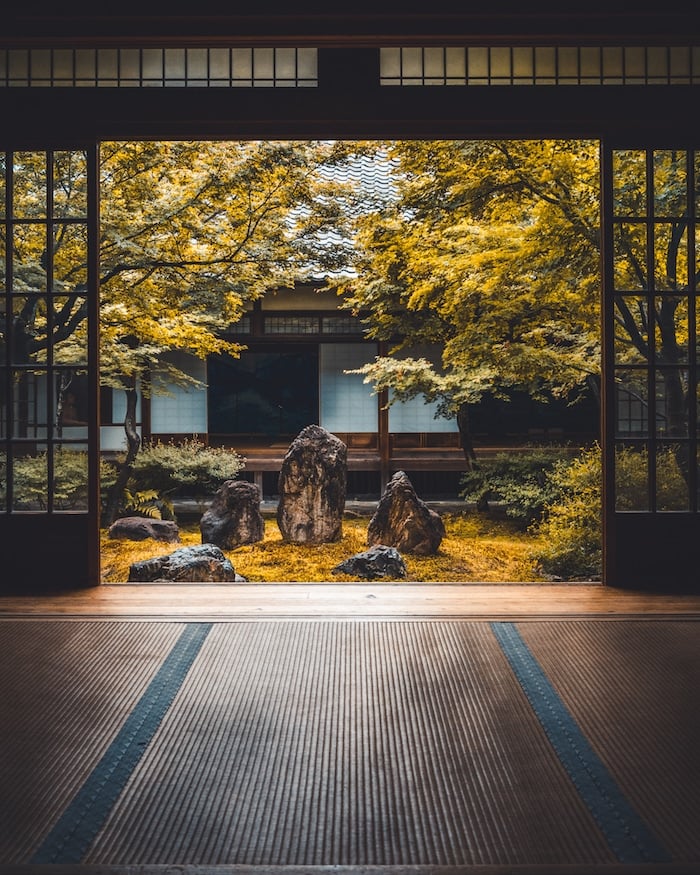
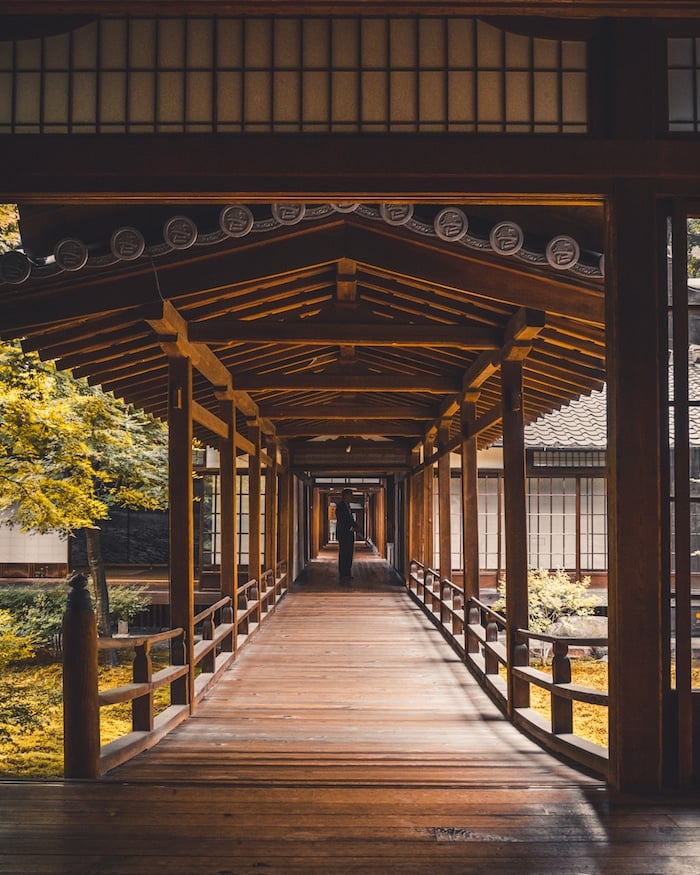
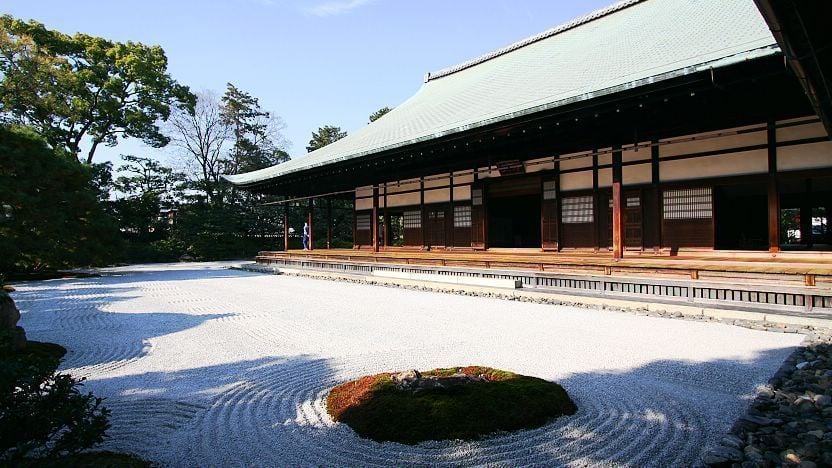
6. Japanese Tea Garden, Golden Gate Park (San Francisco, California)
Designed by Makoto Hagiwara, the Japanese Tea Garden was completely in the early 20th century. It has a Tea House, a Pagoda, a Moon Bridge, and a Rock Garden.
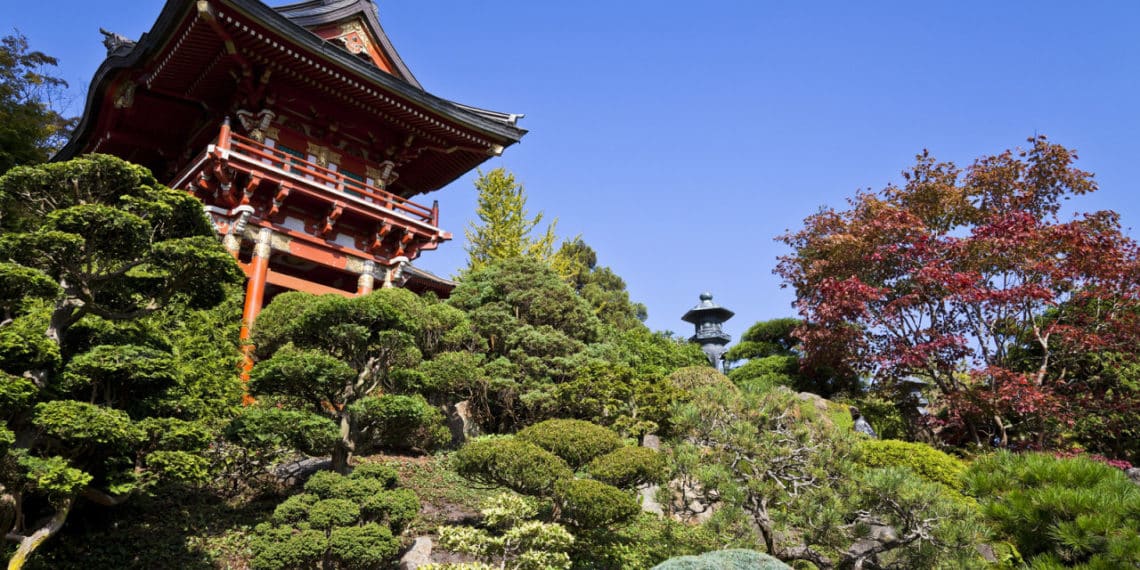
The landscape is meant to represent waves in an ocean. Unlike other Zen gardens outside Japan, it preserves traditional rock garden techniques like the color and arrangement of stones, the asymmetry, and the general geometry of the garden.
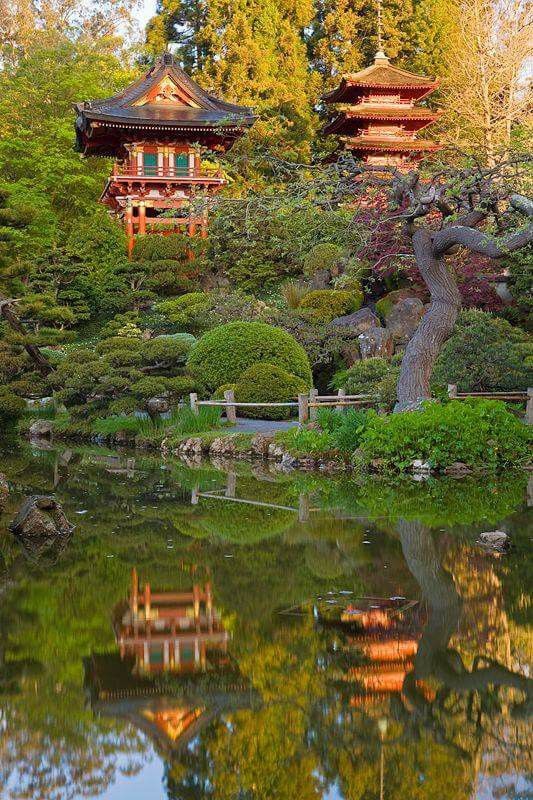
7. Isamu Noguchi Garden Museum (Kagawa, Japan)
The Japan Museum is located on the island of Shikoku in the Kagawa prefecture of Japan. Its collection includes 150 sculptures, hand-crafted by the Japanese-American artist Isamu Noguchi.
During his time in Shikoku and New York, he gained a reputation for his minimalist sculptures. His collection features a small rock garden comprising numerous granite rocks and a landscape filled with white gravel.
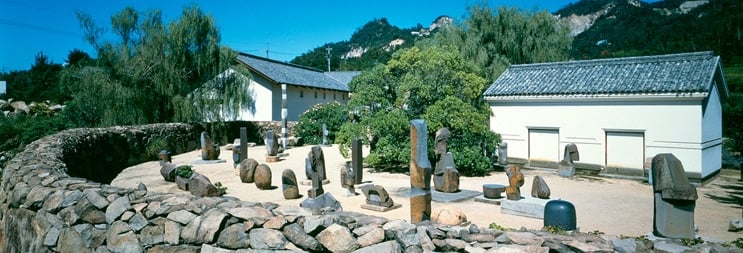
While most of the rocks are smoothened out, few retrain their natural form, preserving the working atmosphere of his studio.
8. St. Mungo Museum of Art (Glasgow, Scotland)
St. Mungo Museum exhibits the first Zen garden in the United Kingdom. The garden has several flat and tall stones, protected by an arc-shaped wall made up of small stones and pebbles.

A perfect harmony of cultures, the visitors picnic in the well-maintained expanse of grass that runs along the carefully raked white gravel of the Zen garden, while sipping hot tea brewed from the fine leaves from the land of the British.
9. Kongobu-ji Temple (Koyasan, Japan)
Part of a UNESCO World Heritage Site, the Kongobu-ji Temple is home to Japan’s largest rock garden.
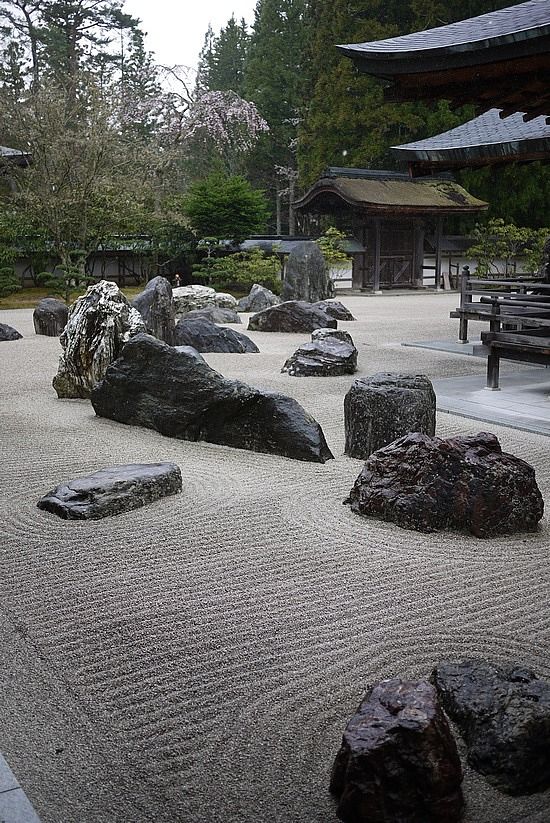
The Banryūtei (蟠龍庭 rock garden) covers more than 2300 square meters in area and the landscape features a grandiose arrangement of one hundred forty granite rocks.
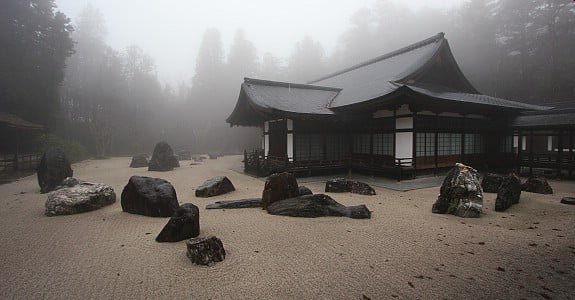
The rocks suggest the presence of two dragons breaking through the clouds to shield and protect the temple.
10. The Huntington Library (California)
The San Marino’s Huntington Library in California is home to numerous botanical gardens. The Japanese garden was incorporated in 1968 to include a bonsai collection and a Zen garden.
Unique to this particular garden is the stone walkway and stone benches that allow visitors to sit and observe the combed gravel bed that sits within the garden walls.
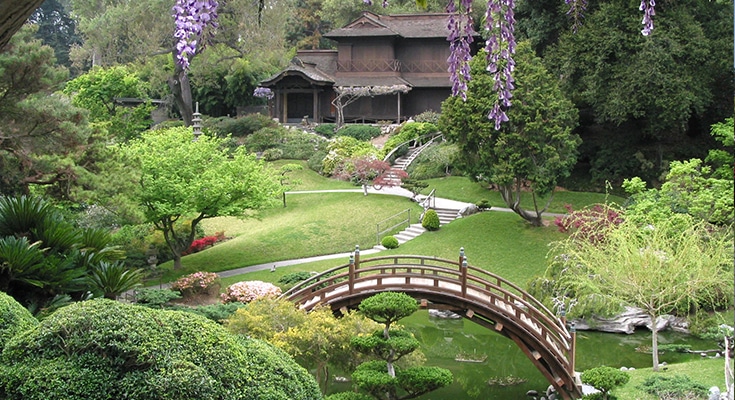
Exclusive to the Harry Hirao Suiseki Court, visitors are invited to touch the suiseki or view stones. The Zen Court exemplifies the concept of contained landscapes which evolved in the temple gardens of Japan.
In this Zen garden, the white gravel, rock formations, and shrubbery symbolize water, space, and movement.
11. Nanzen-ji (Kyoto, Japan)
Built in the 1600s by the notable artist Kobori Enshu, the garden is considered to be a remarkable piece of work.
The garden mirrors natural forms. Consisting of over seventy percent gravel, the ripple-like pattern of the gravel suggests peaceful ocean waves. The boulders give an illusion of mountains in the middle of a pond or ocean.
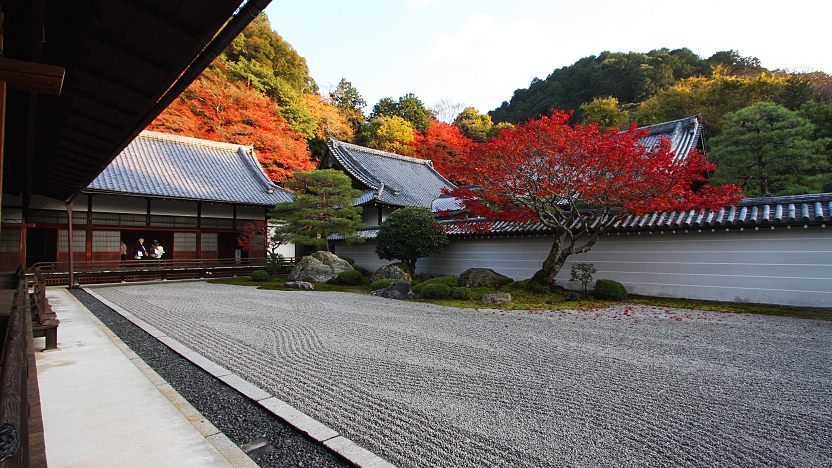
The Nanen-ji’s rock garden inspires meditation. It has been designated a national Place of Scenic Beauty.
12. Daisen-in, Daitoku-ji (Kyoto, Japan)
Popularly known as ‘The Academy of Great Immortals”, Daisen-in (大仙院) is a sub-temple of Daitoku-ji, one of the five most important Zen temples of Kyoto.
Garden historians propose that the garden represents a metaphorical journey through life: the waterfall, river, and sea may represent youth, maturity, and old age while the rocks in the “rivers” suggest obstacles.
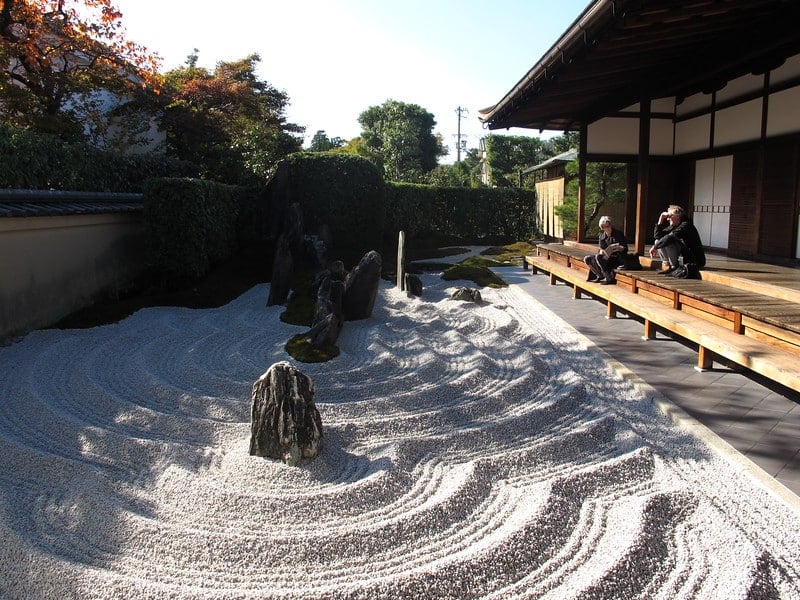
Historians suggest that the garden represents the metaphorical journey through life. The garden begins with a miniature landscape comprising of rocks which leads to a waterfall, signifying birth. The landscape raked with white gravel is thought to be rivers, representing youth.
Large rocks randomly scattered in the river represent hardship and obstacles in life. The river divides into two and flows into a ‘Middle Sea’ and an ‘Ocean’, symbolic of the search for wisdom and old age.
13. Taizo-in, Myoshin-ji (Kyoto, Japan)
Dating back to the early 15th century, this temple was built by the Zen priest Muinsoin and is well known for its two gardens, a pond garden and a traditional karesansui garden.
The Zen garden contains many angular rocks that suggest the cliffs of the island of Hōrai. The smaller rocks surrounding it symbolize a river.
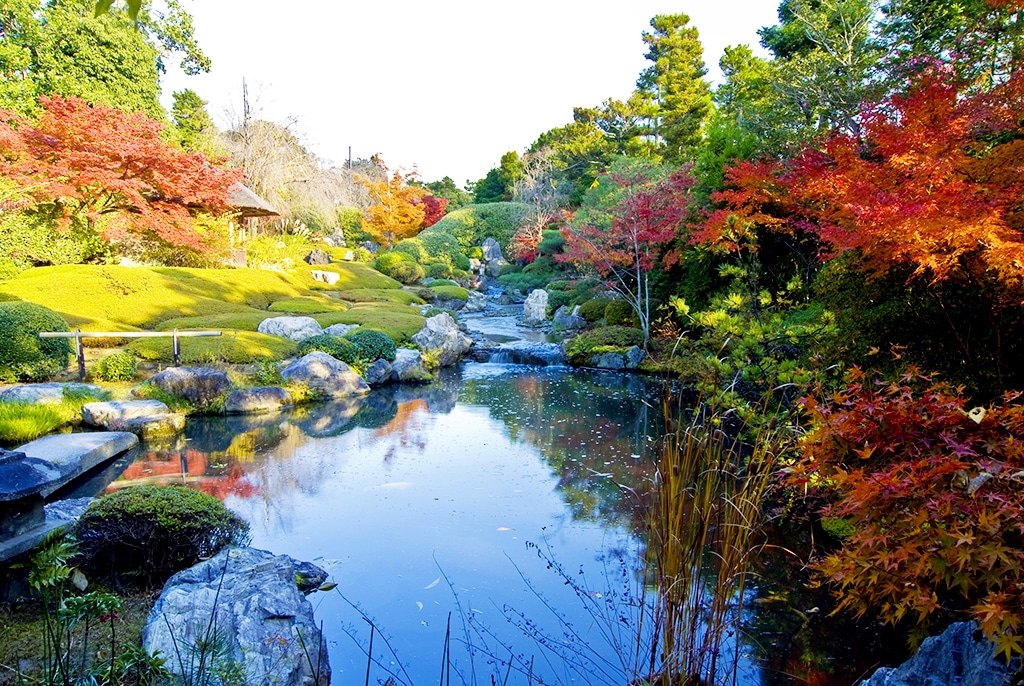
An assortment of trees, including camellia, pine, and the Japanese umbrella pine can be seen. These are kept to amalgamate the shakkei of the nearby Narabigaoka Hill.
14. Zuisen-ji (Kamakura, Japan)
Situated in the picturesque Momijigayatsu valley, Zuisen-ji temple’s head priest Moso Soseki overlooked the design of the temple’s Zen garden in the early 14th century.
With Mt. Fuji as the backdrop, the valley is surrounded by mountains, which provide a natural boundary to the garden. The garden also uses the raw design of rock instead of manipulating them by hand.
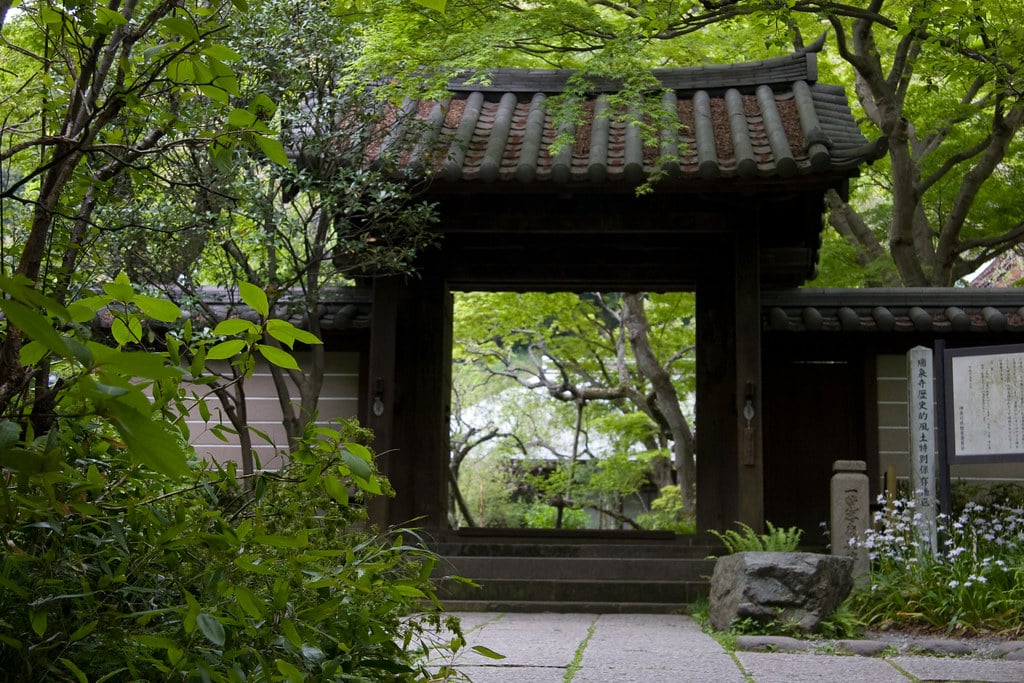
The Zen garden is the last remaining Zen garden in Kamakura which was constructed during the Kamakura Era.
15. Tofuku-ji ( Kyoto, Japan)
A temple reconstructed several times in its brief history of 700 years, the Tofuku-ji Temple in Kyoto is the abode of four exemplary Zen gardens.
The Honbo Gardens, chosen as a ‘Nation Site of Scenic Beauty’ comprises four gardens, the Southern, the Western, the Northern, and the Eastern Garden.
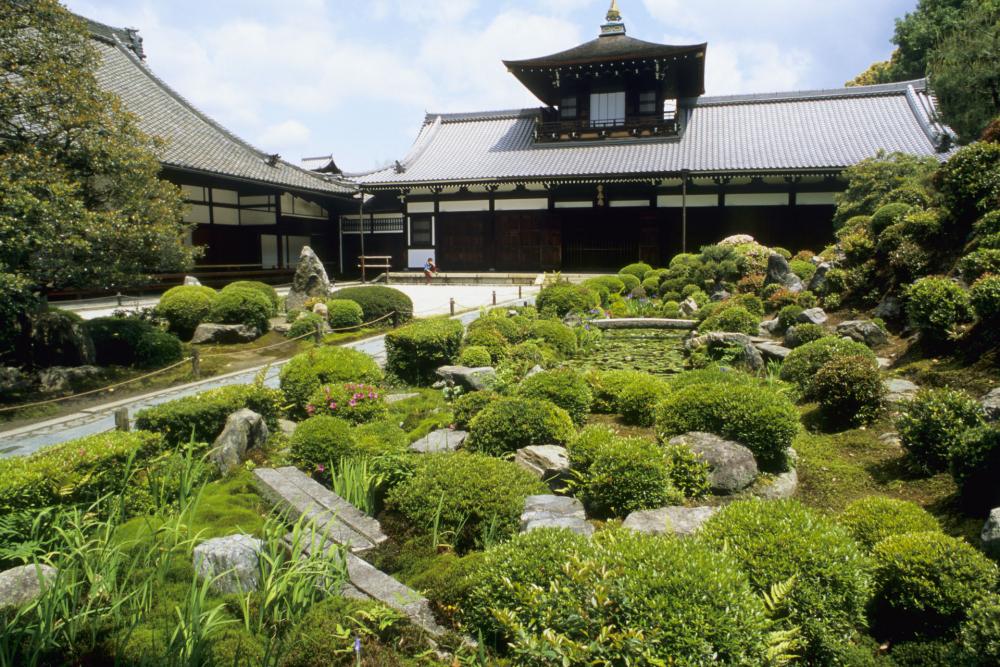
Each designed by architect Mirei Shigemori, the moss garden in particular has been emblematic of the renewal of Japanese gardening principles in the 20th Century.
A large number of Japanese maple trees encompass the gardens. This gets crowded during the fall, as people flock together to witness the picturesque season.
16. Kencho-ji (Kamakura, Japan)
Kenchō-ji is a Rinzai Zen temple that ranks first among the Five Great Zen Temples of Kamakura.
Having 49 sub-temples originally, the phenomenal architecture does justice to all the high praises since its inception in the thirteenth century.
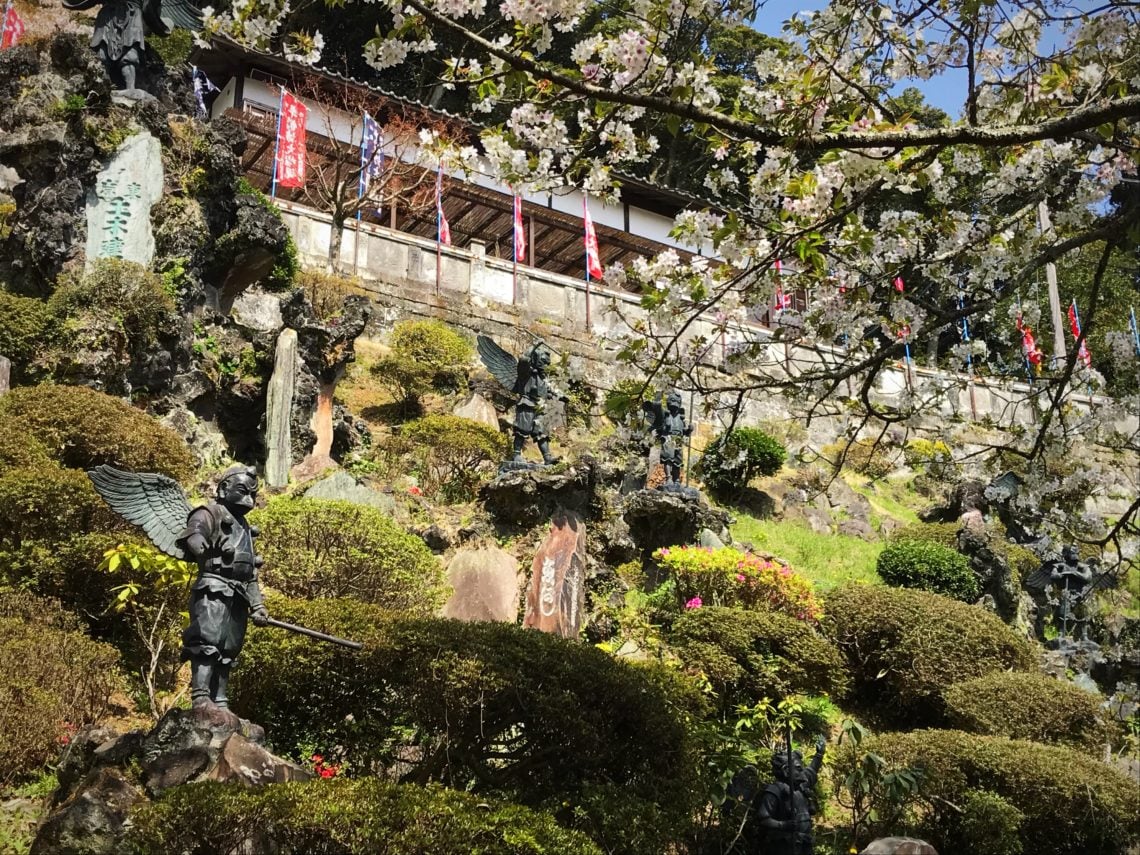
Another masterpiece by the renowned architect and Zen teacher Musō Soseki, the Zen garden residing behind the Hōjō is in the shape of the Chinese character for ‘mind’.
A pond in the middle of the garden adds to the alluring beauty and manifests a sensation of divinity and serenity. The Zen garden thus serves as a great spot for meditation.
17. Komyo-ji (Kamakura, Japan)
Kōmyō-ji is a Buddhist temple that has a long history of receiving the patronage of Japan’s powerful. A cluster of 18 Jodo temples, the Komyo-ji temple is home to a beautiful Buddhist-style Zen garden.
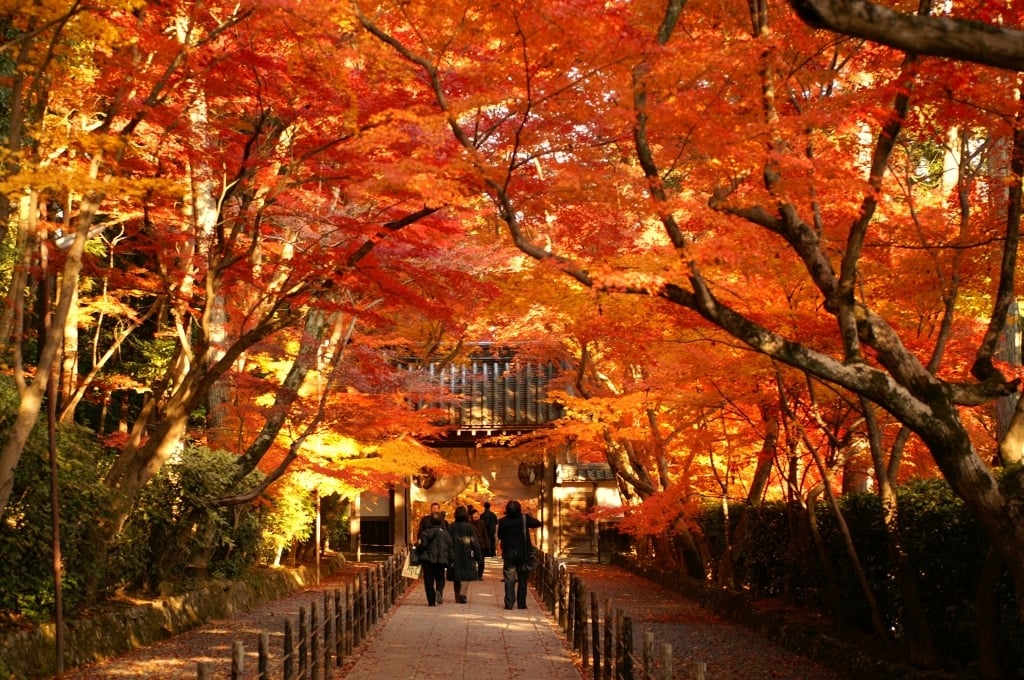
Along with the traditional white gravel, 8 boulders symbolize either a saint or a God. A group of three rocks on the left depict the Amida trinity, while the five towards the right represent Gautam Buddha and four priests.
18. Ginkaku-ji (Kyoto, Japan)
Officially known as ‘The Temple of Shining Mercy’, it is located on the eastern side of Kyoto. It is home to some of the most beautiful gardens in Japan.
The sand garden of Ginkaku-ji is distinctly famous for its two-meter-high cone built modeled from silver sand. This cone is said to symbolize Mt. Fuji and serves as an essential element of the garden.
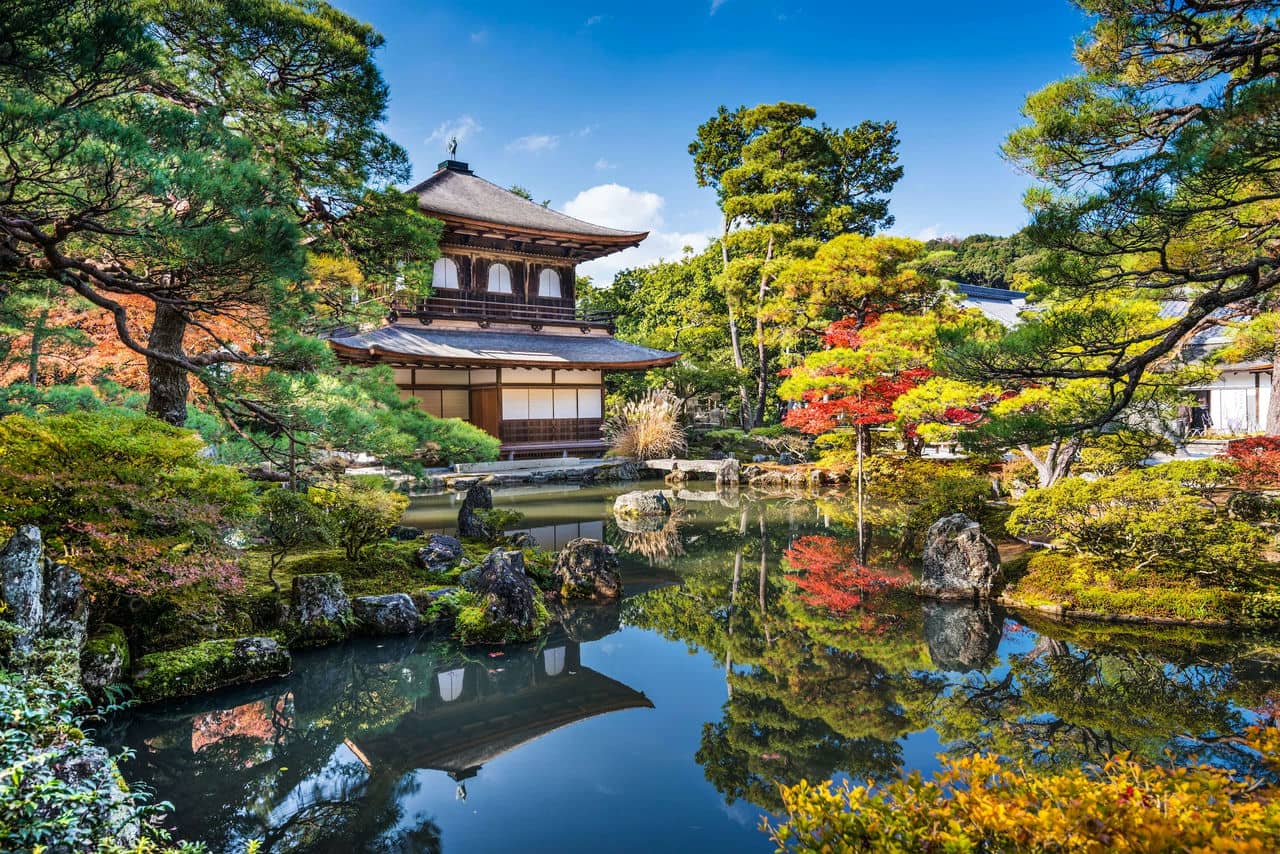
The garden is a token of Zen culture, nevertheless, it should be also enjoyed for its aesthetics as intended.
19. The Japanese Garden of Contemplation (Waikato, New Zealand)
The Japanese Garden of Contemplation is a part of the Paradise Garden collection which is one of the five beautifully designed garden collections in New Zealand’s Hamilton Gardens.
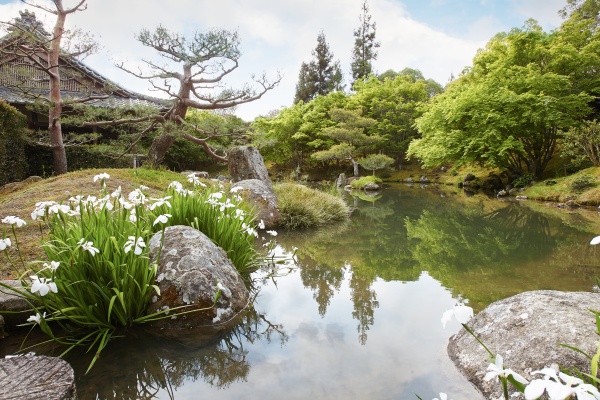
The garden draws inspiration from the traditional Zen gardens of Japan. It includes carefully laid out stones in a traditional pavilion, and a vast restful pond. It’s a minimalist-style garden and encapsulates the viewer with its aura.
20. The Sand and Stone Garden (Portland, OR)
The Sand and Stone Garden is part of The Portland Japanese Gardens which comprises five separate gardens.
The garden closely resembles traditional Zen garden characteristics like minimal vegetation and carefully raked whitish-gray gravel.
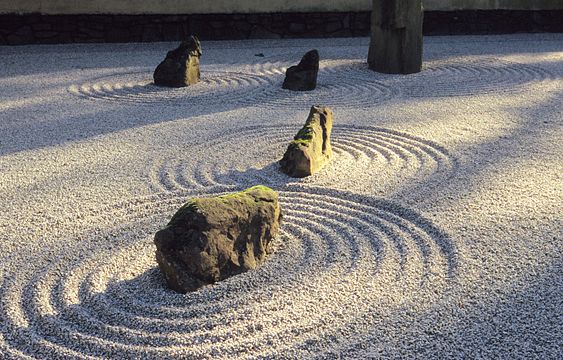
The garden accommodates one large standing boulder and several smaller rocks spread out. The raking pattern of the gravel signifies waves in the ocean and looks like ripples in a pong.
21. Tenryu-ji (Kyoto, Japan)
Traditionally known as the ‘Temple of Heavenly Dragon’, Tenryu-ji is a 14th-century temple in Kyoto designed by the renowned Muso Kokushi. The garden features a big pond and boulders are positioned carefully along the boundary.
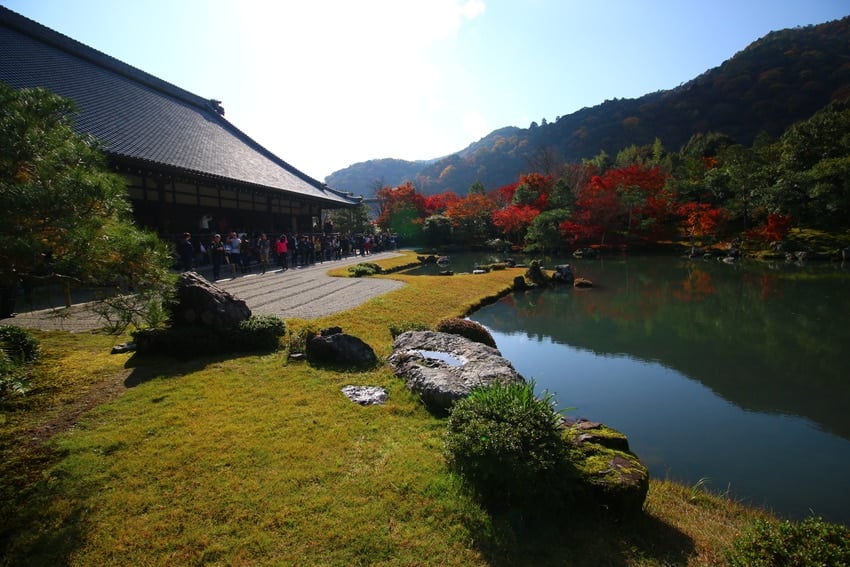
It is famous for the majestic scenery painted by the breathtaking view of the reflection of Maple trees that surround the garden. Tourists by the thousands flock together to witness the sight, especially during the fall.
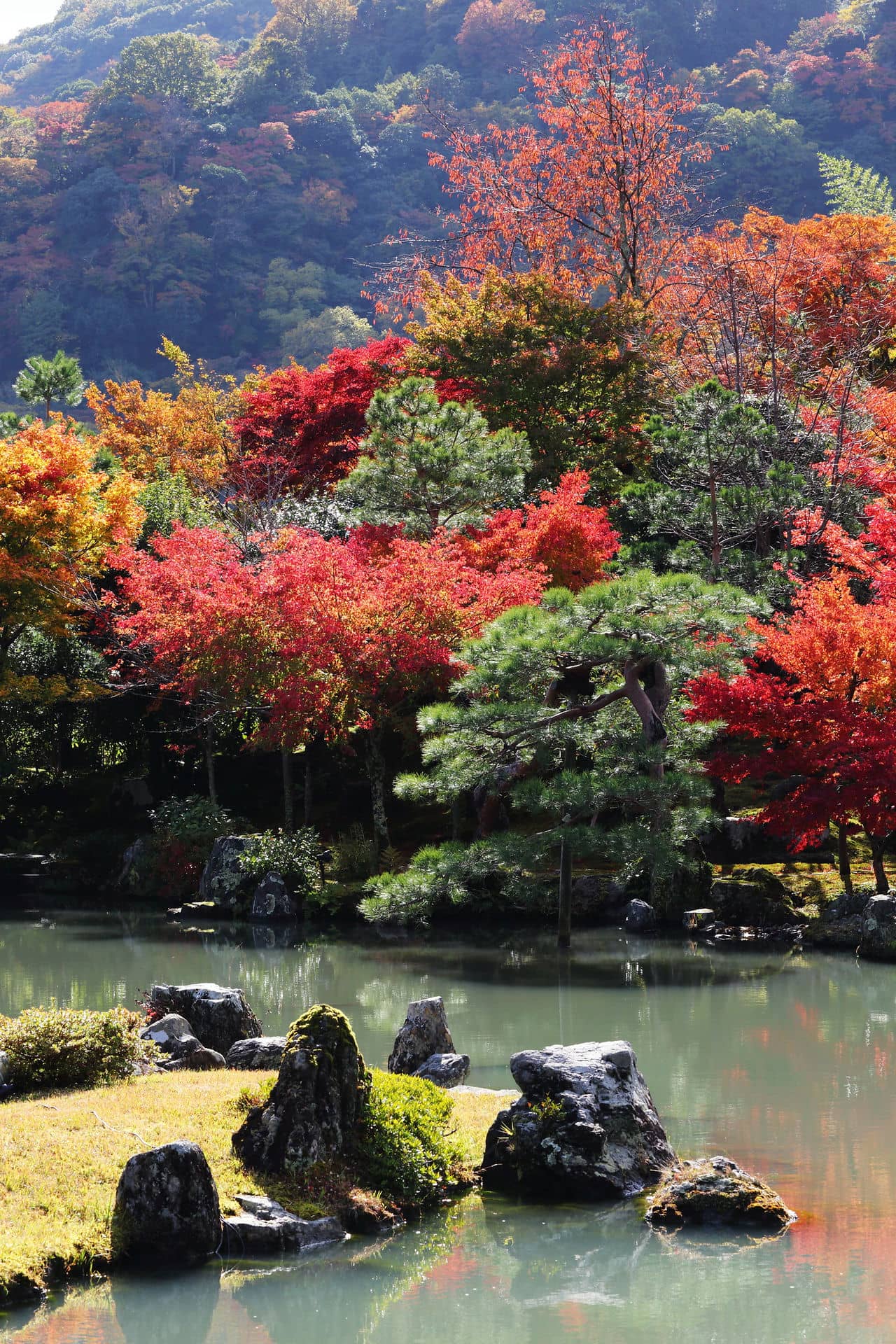
22. Zen Garden, Bloedel Reserve (Bainbridge Island, WA)
The Bloedel Reserve is a gigantic 150-acre forest garden in Washington State. Inaugurated by Prentice and Virginia Bloedel, it features a beautiful Japanese garden that captures the essence of the Japanese Zen gardens.
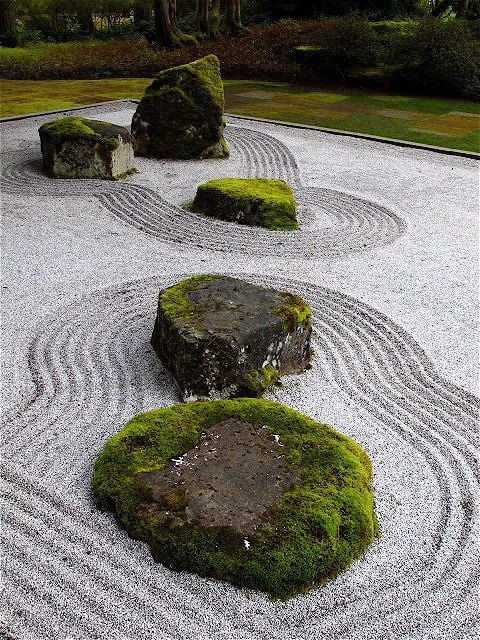
This meticulous piece of art emulsifies the Western expression of a Zen garden with the traditional Japanese qualities of naturalness, reverence, and tranquility. The garden even includes lakes and lawns, something distinct from the traditional Zen gardens.
23. Saiho-ji (Kyoto, Japan)
A part of the “Historic Monuments of Kyoto” list, Saiho-ji, which is famously known as the Moss Temple was restored by the eminent monk and garden designer Muso Soseki.
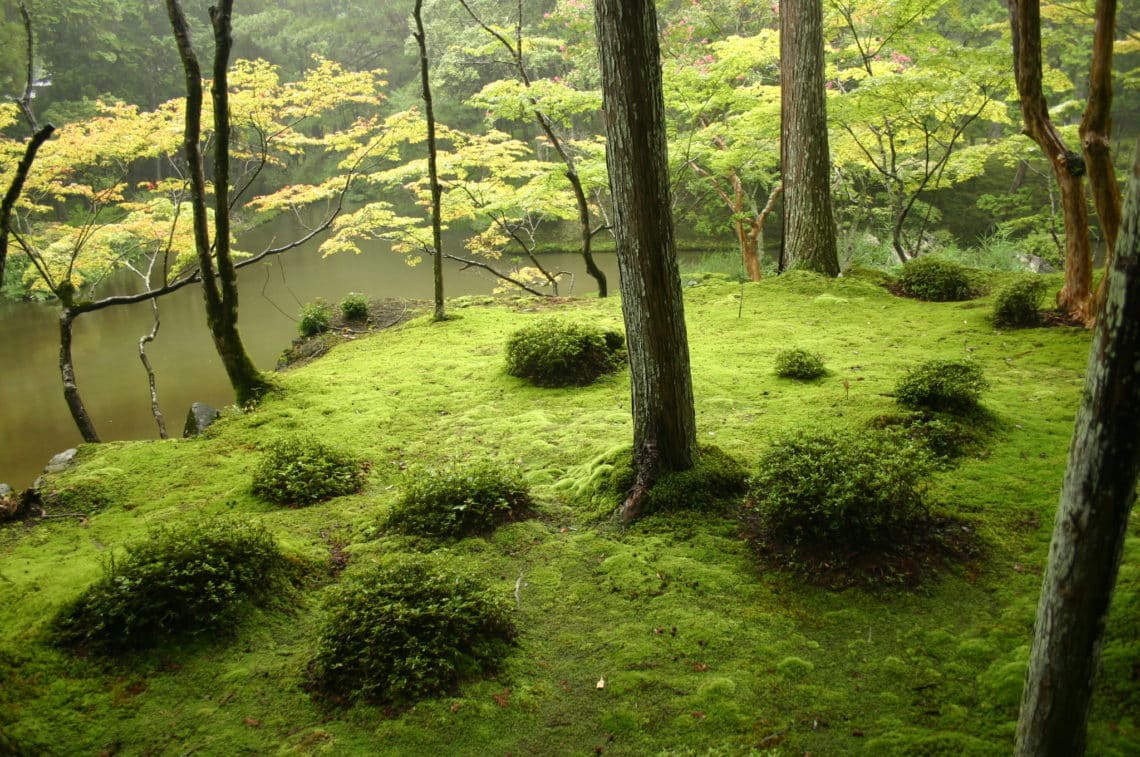
Over 120 different types of moss exist in the rock garden, mimicking a grass blanket with different hues and shades. The garden features a pond known as the ‘Golden Pond’ which is in the shape of the Chinese character for heart.
24. The Adachi Museum of Art (Yasugi, Japan)
A Michelin 3-star venue in the Michelin Green Guide Japan, Adachi Museum of Art has 6 Japanese gardens and a collection of over 1500 paintings, poetry, and artworks.
The Zen garden comprises three standing rocks in the center which represent a waterfall, which converges with the great river as symbolized by the white gravel. The profound beauty of nature is wonderfully recreated using the dry landscape technique.
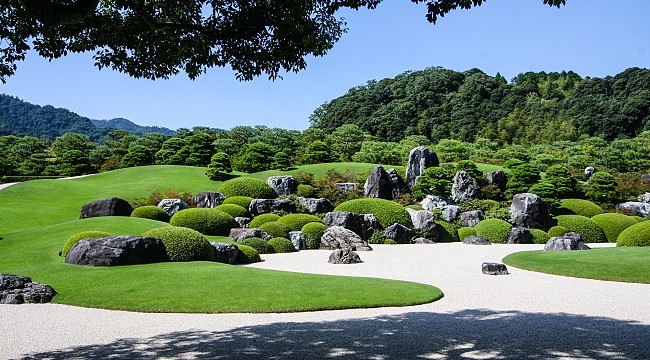
The mountains in the background have Mt.Katsuyama in their center. Mt Katsuyama lies in the center of the mountains present in the background and serves as a borrowed scenery or shakkei.
25. Japanese Garden, Morikami Museum (Delray Beach, FL)
The Morikami Museum houses an incredibly designed Zen garden in the yard, which includes rock design styles from both the Early and Late period rock-themed gardens.
Created all the back in the time between 199 and 2001 by Hoichi Kurisu, the Morikami Museum garden is perhaps the only Zen-based garden in the US that dedicates itself to the living history of Japan.
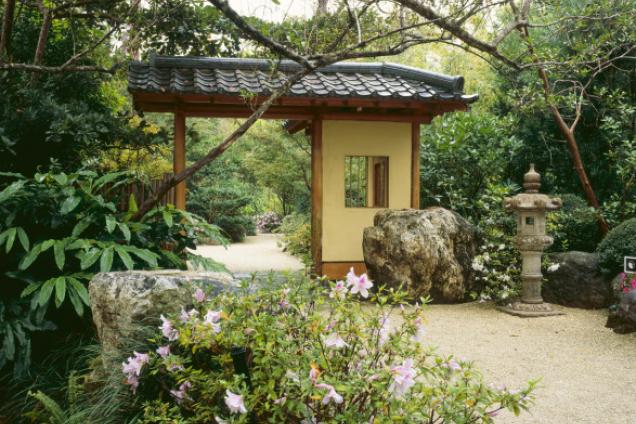
Apart from spirituality, this garden further goes on to evoke a sense of romance and love for those around. The extensive bonsai collection adds very much to this effect, and aesthetically it goes perfectly well with the groomed gravel and the naturally shaped boulders.
Much contrary to the Zen practice of limiting vegetation, this garden breaks the mold here with the bonsai collection, and the effect it creates is mesmerizing, to say the least.
26. Seattle Japanese Garden, Washington
Right in the very heart of Washington, in Seattle to be more precise, there is a Japanese garden that is known to create one of the most calming and stimulating effects on the busy and stressed mind.
The Seattle garden is as traditionally Japanese as a Zen garden can get. It contains small lanterns at various intervals to give off a sort of medieval appeal that goes back to the traditions of the Edo era.
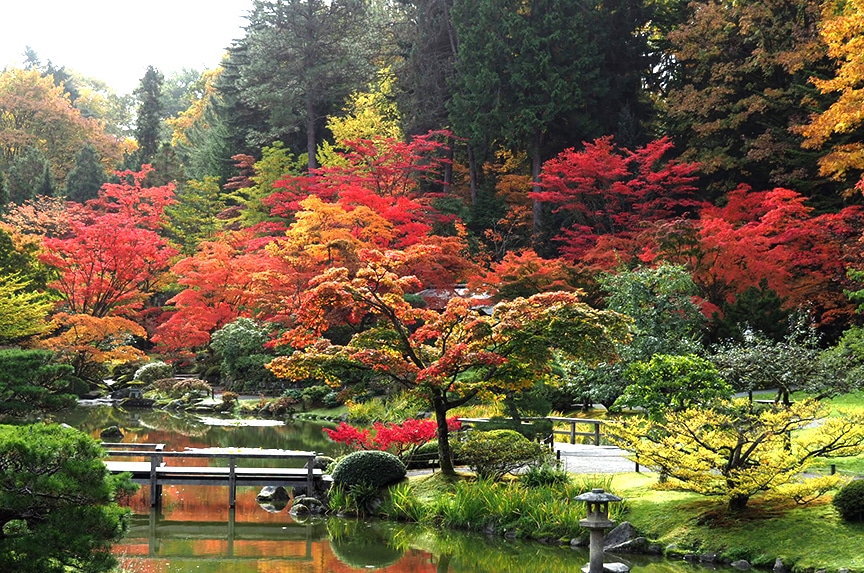
Small lakes and bridges are also a staple to the Seattle garden, along with Sakura trees and Japanese maples, thereby making it incredibly authentic. Taking a seat below a tree here and watching the seasons go by can truly be the experience of a lifetime.
27. Shofuso Japanese House and Garden
Ever heard of an entire garden being uprooted and then later on transplanted at a completely different time zone?
Well, that is exactly what happened with the Shofuso Japanese House and Garden. Originally built in Nagoya, Japan, this garden was then in 1953 transplanted in Philadelphia and has been one of the most popular tourist spots in the entire Commonwealth of Pennsylvania.
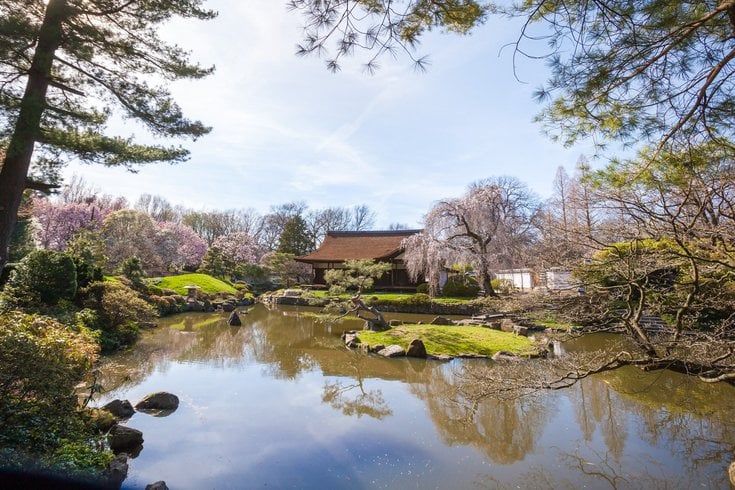
One of the most attractive features of this garden is the quaint little tea spot that is surrounded by a courtyard on one side and a large hill garden on the other.
The Shofuso House, apart from being a cultural center doubles as an art gallery and houses innumerable paintings by Hiroshi Senju who based most of his works on the Nihonga style, especially on the fusama buildings.
28. Japanese Garden at the Chicago Botanic Gardens (Glencoe, IL)
If you watch the Kurosawa or even some of Takeshi Kitano movies, you will notice that Japanese culture puts a lot of ethos on the aged, or rather, fermented and the natural.
The Elizabeth Hubert Malott Japanese Garden in Chicago looks like something that has been taken out of the history books. Defined by its iconic half-buried rock formation, this garden will allow you to take a step back in time and let you appreciate history and tradition that has long mutated and changed ever since.
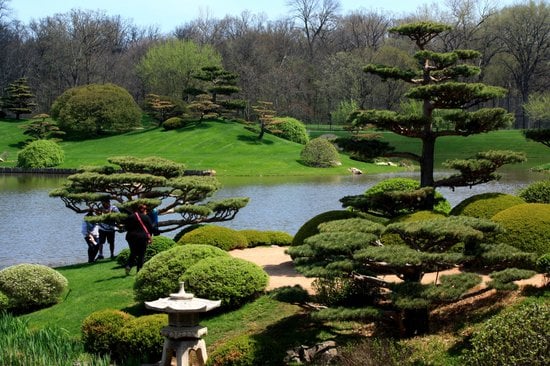
The rocks are moss-covered, the pine trees are weathered, and the flower is allowed to grow wherever they please…the whole garden is left to the mercy of nature, and that is the unique beauty that this garden possesses.
29. Meijer Gardens & Sculpture Park in Grand Rapids, Michigan
The Meijer Gardens & Sculpture Park in Grand Rapids is all about taking up the traditional Zen garden design and mixing it with a lot of contemporary elements to make it a much more potent spot of escape and relaxation.
The garden houses many modern-day sculpture models which make the garden have a rather subtle blend of the Japanese Zen and the British tradition of garden sculptures.
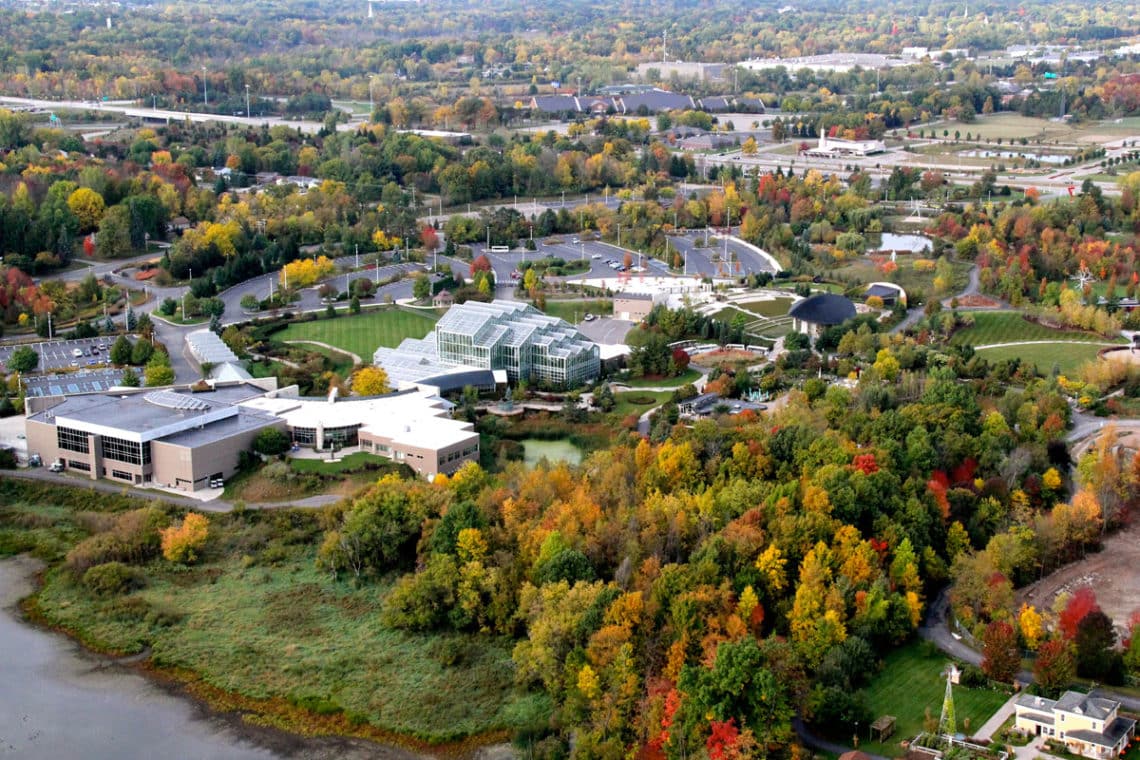
It contains sculpture models from some of the world’s most notable sculptors such as Jenny Holzer and Anish Kapoor which imparts a sort of tranquility to the surrounding environment.
30. Brooklyn Botanical Garden, New York
The Brooklyn Botanical Japanese-themed garden has one of the most mesmerizing sakura tree collections in the entirety of the United States.
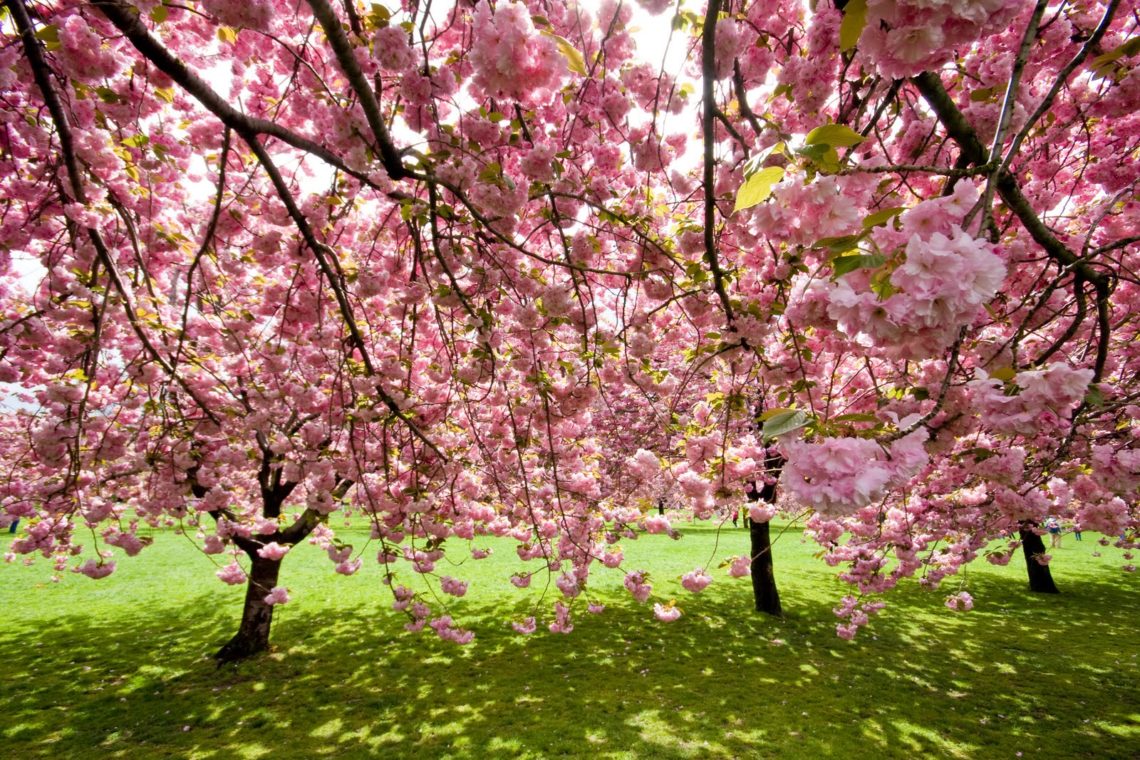
Every spring, from March; the garden holds a cherry blossom festival that celebrates the coming of spring, which is much like the original Japanese tradition where friends and family go out to picnic below the trees and watch it while it blooms. Cherry Blossom festivals are a must-have experience if you live in or near New York.
31. Portland Japanese Garden, Oregon
Described by the former Ambassador of Japan to the US as ‘the most beautiful and authentic Japanese garden in the world outside of Japan’, this stunning urban oasis overlooks the city of Portland. Designed in 1963, it includes five different garden styles, which are designed to express serenity, tranquility, and the aestheticism of nature.
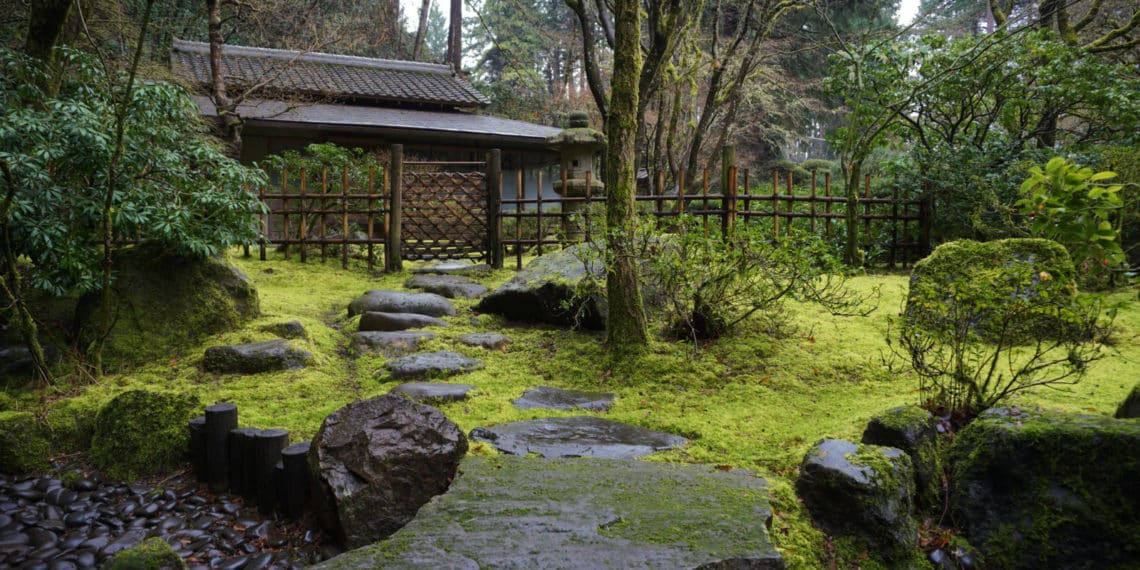
Immerse yourself in some Japanese culture in one of their cultural demonstrations, or take a walk through the Strolling Pond Garden.
Long story short, get started!
Creating your dream garden can be as easy as getting started, with the right plants and the right gardening products your passion for greenery will guide beautifully!
What are you waiting for?
